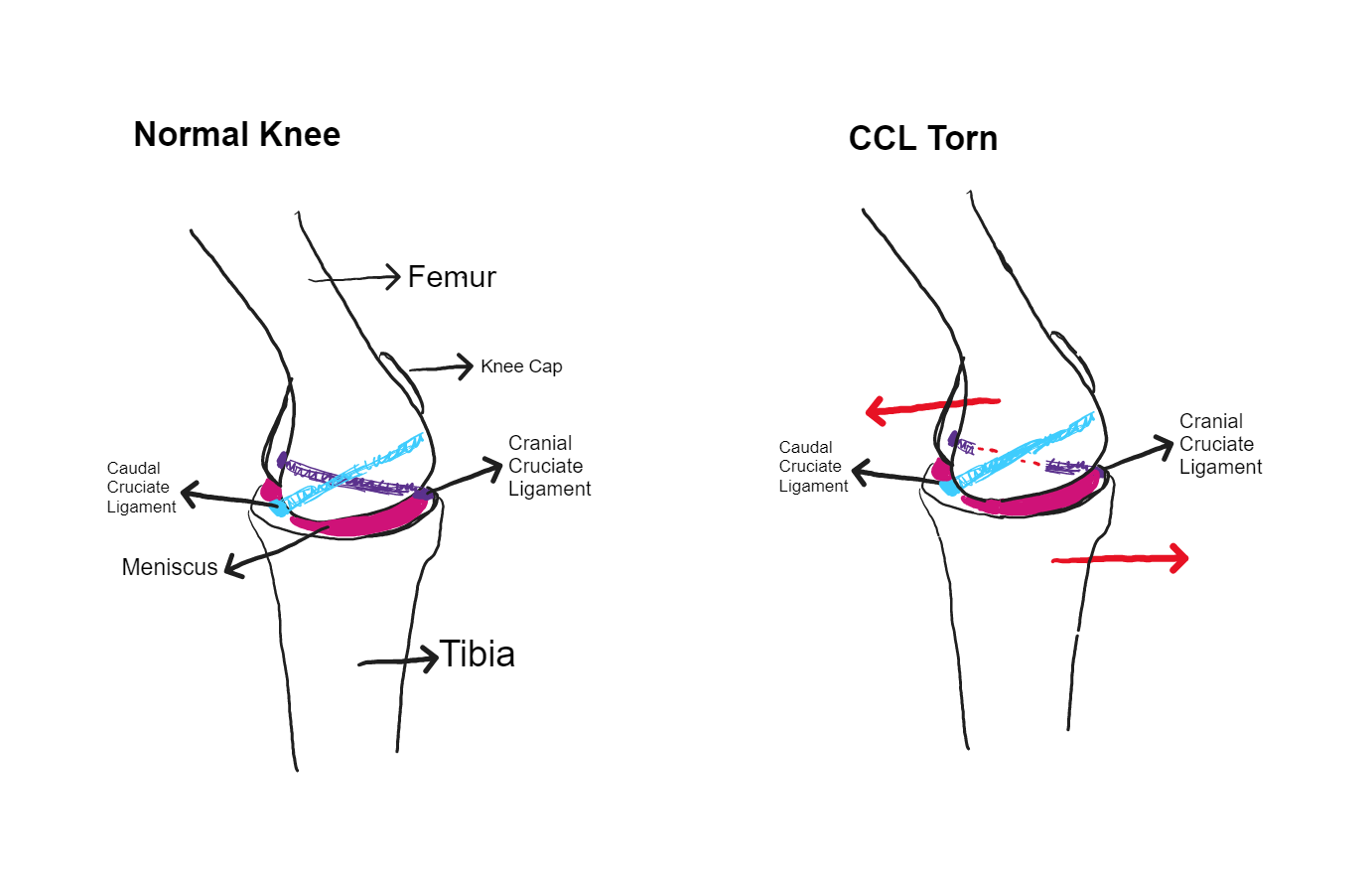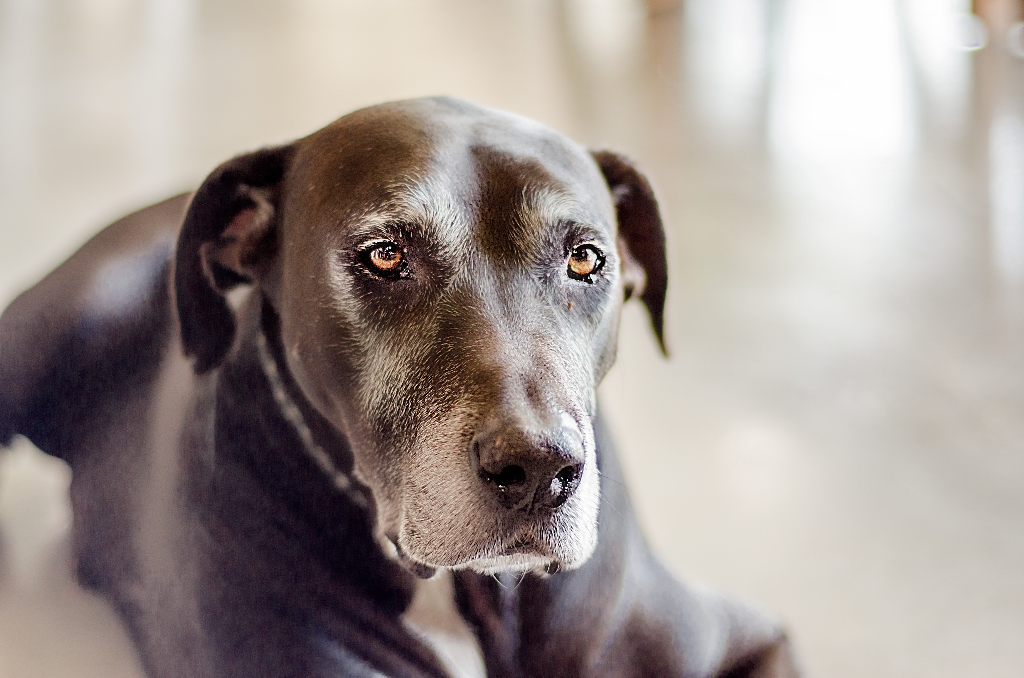The Cranial Cruciate Ligament (CCL) in dogs and cats is the same thing as the Anterior Cruciate Ligament (ACL) in people. This is one of numerous ligaments that are present in the knee joint that help the knee joint bend the correct way. The CCL is attached to the back of the femur (thigh bone) and extends to the front of the tibia (shin bone). Opposite the CCL there is a ligament called the caudal cruciate ligament that attaches at the front of the femur and to the back of the tibia. These two ligaments work together to keep the tibia from sliding forward and backwards. The other ligaments in the knee joint help stabilize the joint.

Just like for the ACL in people, the Cranial Cruciate Ligament is the ligament that is most commonly damaged in companion animals. In people this injury usually occurs from a traumatic injury sustained from an unusual twist of the knee, like when playing sports. This can be the case in animals, but unlike people, a tear is usually caused by something very ordinary. Often they will have a weakening of the ligament over time and the tear will occur when doing something that is part of their everyday routine, like jumping off the couch or chasing a squirrel.
Most of the time we notice this when the animal starts suddenly limping or holding up the leg. Because it is usually an ordinary event that causes the tear, this can seem to come out of nowhere.
When this ligament is broken it makes the knee unstable. The tibia can move forwards and the femur can move backwards. This motion is not normal and can be very painful. The tear and the abnormal movement causes inflammation at the knee and can even tear the meniscus of the knee, which are two little cushions that sit between the tibia and femur. This can cause further pain and swelling.
Diagnosing a CCL rupture can usually be done at your general veterinarian. Your vet may watch your pet walk and feel the joints of the legs. Sometimes an x-ray will be recommended. In some cases the tear may not be as obvious and therefore more advanced diagnostics may be needed to confirm if there is a CCL rupture.
Prevention
Genetics play a large role in CCL injuries, but being overweight plays a large part as well. It is important for caregivers to help pets maintain a healthy weight, and good body condition. Daily exercise and a healthy diet are key. Both of which can be discussed with a Veterinarian to help make a plan.
Treatments
Treatments available for a torn CCL can be surgical, medical, or more commonly a combination of both.
There are several types of CCL surgery. The most commonly performed is a TPLO. This is a Tibial Plateau Leveling Osteotomy. For this surgery a portion of the back side of the tibia is cut and repositioned in a way to provide more stability for the joint. A bone plate is screwed on so the cut part of the tibia stays in place while the bone heals back together. The plate will usually stay in place for the rest of the patient’s life.

Recovery after this surgery is 8 weeks on average. Strict cage rest is required to prevent complications. While rare, complications can and do occur. These include the bone not healing back together, infection at the site—specifically at the bone plate, the bone plate or screws breaking, or a reaction to the bone plate. In some cases the plate will need to be removed.
The main advantage of a surgical treatment is that it often provides a very predictable outcome and recovery time. The main disadvantage is cost, which can be several thousands of dollars.
Medical management is also an option for those who do not wish to pursue surgery. This will most commonly mean treating the pain for a few weeks or months in hopes that scar tissue will form and the pain will decrease over time. Anti-inflammatories are commonly used, as are other pain medications. In addition, alternative therapies are available such as acupuncture, laser, medical massage, temperature therapy, stem cell therapy, and physical therapy.
When treating medically or with surgery, it is important to manage the weight of the pet. Usually, this means weight loss and can significantly aid in healing and recovery.
Owners and caregivers should talk to a veterinarian before starting any of these treatments. Many treatments can be done at home, some can be performed by any veterinarian, but others may require a referral to a specialized rehabilitation veterinarian. Many of the treatment options can also be combined with surgery to help with recovery as well.
The main advantages of medical management are cost and flexibility. Oftentimes surgery isn't an option for one reason or another, and medical management is more appropriate. The main disadvantage is an unpredictable recovery. The time for recovery can vary quite a bit as compared to surgery, often taking 8-16 weeks to see any significant improvement.
With any treatment of a CCL rupture there will be life long changes to the knee joint. There will be arthritis and a thickening of the joint. Some dogs who already have advanced arthritis or mobility issues may struggle much more with recovery than those who are otherwise very healthy. It is always possible for a dog to injure the CCL on the other leg at some point in their life. Maintaining a healthy weight and a daily exercise routine is the best preventive medicine for these cases.

